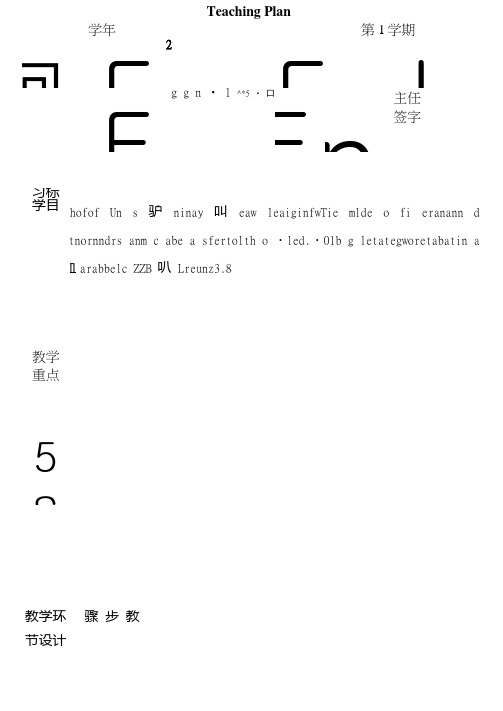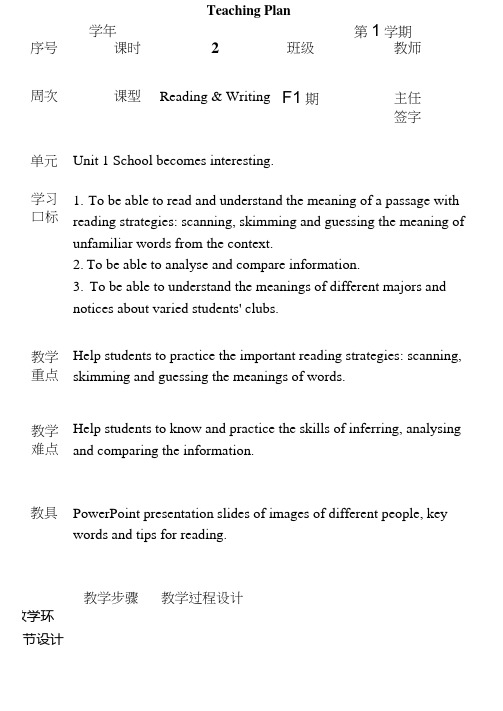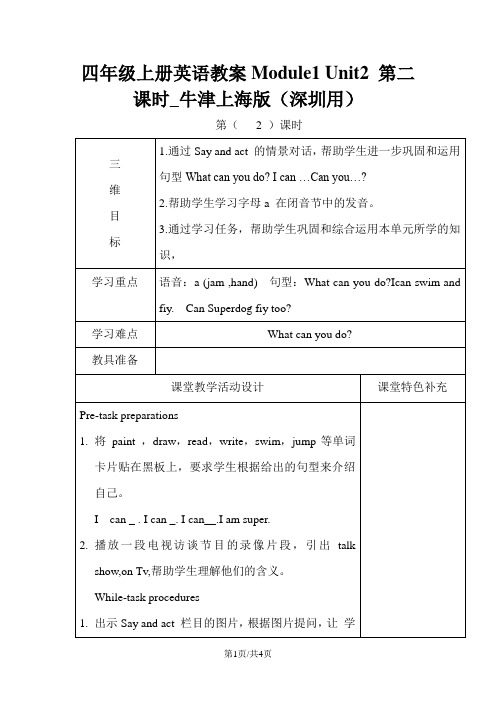捷进英语1Unit2电子教案
- 格式:doc
- 大小:59.51 KB
- 文档页数:5


冋F2F H F g g n • 1 ^*5 • 口F n主任签字习标学目hofof Un s 驴ninay 叫eaw leaiginfwTie mlde o fi eranann ddtnornndrs anm c abe a sfertolth o ・led.・01b g letategworetabatin a血arabbelc ZZB 叭Lreunz3.8教学重点5S教学环节设计骤步教Teaching Plan学年第1学期£?耐Warmingup1. Ask students to look at the photos about "Jack', and"Alice” and discuss the following questions: What ishe/she like ?Whom clo you want to make friends with ?IL Introduce the learning content to the students: They aregoing to read some short passages about their familiesand friends-Pre-readingI.Present some new words on the slide. Tell studentstheir meanings and pronunciations.II.P resent the following questions and the picture of Jackon Page 19, and then ask students to predict:How old is the boy?What is important for a happy fain ily?Readingpractice (1)I.Ask the students to skim the passage on Page 19, andtry to answer the above questions. Give the studentssome advice about reading skills.II.P lay the tape. Ask students to read after the tape andunderline the important phrases・ Explain themeanings of these phrases to students.III.Ask students to read the sentences in Activity ②,and then ask them to discuss in groups and expresstheir opinions. Tell students they may start like this: Ithink... or I don^t think...Reading practice (2) I.Ask the students to read the passage on Page 20, and then answer the following questions:How often does Alice write to her grandparents?Do you think Alice will make more friends at her new school?II.P lay the tape. Ask students to read after it and underline the important words and phrases. Explain their meanings to students.III.Ask students to read again and work in pairs to fill in the form of Activity ④ on Page 20.教学环节设计Readingpractice (3)I.Ask students to read a letter from Sue on Page 21, andthen answer the following questions:Whom does Sue write to?What problems does Sue have at her new school?What is Sue like ?II.P lay the tape. Ask students to read after it. Present theformat of an English lette匸III.Ask students to read the sentences of Activity ⑥ inpairs, and then discuss the proper way for Sue to makefriends.IV・ Divide the students into groups. Suppose they areNancy, ask them to write a letter back to Sue on “Howto Make Friends".Consolidati on I- Ask students to take part in a competition. Ask them to make a list of how to keep in touch with their friends and families.II.P resent some Chinese sentences on the slide, which are about the students5 problems of studies or life. Ask them to speak out in English・III.Encourage them to write more sentences about th&r studies or life.Summary Key vocabulary: waste miss phone understand grown-upcommunication be busy with have much to do sth.chat with try one5s bestkeep in touch with make friendsKey sentences:They don't have much time to talk with me.She hopes she will make more friends at her newschool-I want to make new friends, but I don^t know how.Homework 1.Ask the students to memorise the phrases and keysentences.2.Ask students to investigate in their group how tocommunicate with their families and friends・ They willshow the result of their survey in the next class.3.Ask students to preview the part of "Around theWorld^ on Page 23 and look up the new words indictionaries.。

序号课时2班级教师周次课型Reading & Writing F1期主任签字单元Unit 1 School becomes interesting.学习口标1.To be able to read and understand the meaning of a passage with reading strategies: scanning, skimming and guessing the meaning of unfamiliar words from the context.2.To be able to analyse and compare information.3.To be able to understand the meanings of different majors and notices about varied students' clubs.教学重点Help students to practice the important reading strategies: scanning, skimming and guessing the meanings of words.教学难点Help students to know and practice the skills of inferring, analysing and comparing the information.教具PowerPoint presentation slides of images of different people, key words and tips for reading.教学环节设计教学步骤教学过程设计Teaching Plan学年第1学期教学坏节设计Warming up I. Ask students to look at the pictures in Activity ①on Page 9 and discuss the following questions: Whereare they?What are they doing?II. Introduce the learning content to the students: Theyare going to read an e-mail about Li Wei,s schoollife.Pre-reading I.Present some new words on the slide. Tell studentstheir meanings and pronunciations.II.Present the following questions to students:Where is Li Wei studying now?Where do Li Wei and his classmates work?Do they have classes in factories?Readingpractice (1)I.Ask the students to skim the e-mail on Page 9, andtry to answer the above questions. Give the studentssome advice about reading skills.II.P lay the tape. Ask the students to read after the tapeand underline the important phrases. Explain themeanings of the difficult phrases to students.Encourage them to make sentences with thesephrases.III.Ask the students to read the e-mail again, discusswith their partner, and then fill in the form inActivity ②.IV.Check answers with the students.Reading practice (2) I.Ask the students to read the introduction of three majors on Page 10, and then answer the following questions:What are the main subjects of the major Accounting? What is the future job of the major Travel and Tourism ?II.Play the tape. Ask the students to read after it and underline the important words and phrases. Explain their meanings to students-III.Ask the students to read again and work in pairs to choose suitable majors for the people in Activity ④on Page 10.K 耐Readingpractice (3)I.Ask the students to read the notices on Page 11, andthen answer the following questions:When should you go to meet us if you like takingphotos?Where should you come if you are good atprogramming?What time should you come if you like dancing ?Which room should you go to if you are crazy aboutpop music?II.Play the tape. Ask the students to read after it andthen write down the names of different clubsaccording to the notices.III.Ask the students to read the notices again anddiscuss in pairs which club they would like to join in.Consolidatio n I.Ask the students to talk about their major and what the main subjects are.II.P resent some pictures of different school activities to students and ask them what activities they would like to take part in.III.Encourage them to write more sentences about their school life.Summary Key vocabulary: vocational cashier tour guide hotel staffmodern machine major main subject future job carefultake photos after schoolhave fun with be crazy about pop musicKey sentences:In the morning, we study English and maths in theclassroom.Some of us work as cashiers in shops or as tour guidesfor travel agencies-He is very careful and likes to work with numbers-Homework 1.Ask the students to memorise the phrases and keysentences.2.Ask the students to write a notice of their own. Theymay write down the names and major activities of theclubs and talk about when and where to join them.3.Ask the students to preview the part of "Around theWorlcT on Page 13 and look up the new words indictionaries.。



捷进英语Unit 2老猴子咬菜根学习交流Unit 2 Lesson 1 Baby talk. 儿语Hi Sherise. 嗨,Sherise。
Hello Sherise. 你好,Sherise。
Where's Sherise? Sherise去哪儿了?Has Sherise gone to the movies? Sherise去看电影了吗?No,she hasn't. 不,没有。
She's right here! Wuh-wuh-wuh... 她就在这儿!Excuse me? 对不起。
Oh! Good morning. 噢!早上好。
Good morning, Wendy. 早上好,Wendy。
Friend of yours? 你的朋友?That's Sherise. 她是Sherise。
Where's Sherise? Sherise在哪儿?Sherise is in the restaurant. Sherise在餐厅。
The question is, who is Sherise? 问题是,Sherise是谁?Nina's baby. Nina的小孩。
Oh. 噢。
And where is Nina? 那么Nina在哪儿?She's at a meeting. 她在开会。
And where's the meeting? 在哪儿开会?At the Children's Center. 在儿童中心。
Nina's gone to a meeting at the Children's Center, and her baby is here?Nina去儿童中心开会了,而她的孩子在这儿?That's right. 对。
Has Sherise gone to the meeting? Sherise去开会了吗?No,she hasn't.没有。
捷进英语Unit 1老猴子咬菜根学习交流Unit 1.1 Introductions I 介绍ⅠReceptionist: Quercio?Quercio?Tony Quercio: Yes,Q-u-e-r-c-i-o, Quercio.是的。
Q-u-e-r-c-i-o, Quercio。
Receptionist: Oh,yes.Here it is.噢,对,找到了。
Barbara Seaton : Execuse me .Are you Tony Quercio ?打搅了。
您是Tony Quercio吗?Tony Quercio : Yes,I am.对,我是。
Barbara Seaton :Are you here for the American Library Association Conference?您是来出席美国图书馆协会会议的吗?Tony Quercio : Yes.是的。
Barbara Seaton : My name's Barbara Seaton.我叫Barbara Seaton。
Tony Quercio : You're Barbara Seaton!您是Barbara Seaton!Barbara Seaton : Yes!对,我就是!Tony Quercio : Barbara Seaton of the New York Library?Barbara Seaton,您是纽约图书馆的Barbara Seaton吗?Barbara Seaton : Tony Quercio,Watson's Bookstores?Tony Quercio,您是Watson书店的Tony Quercio吗?Tony Quercio : Yes.对。
Barbara Seaton : How do you do?您好!Tony Quercio :How do you do?您好!Barbara Seaton : Nice to meet you finally.终于见到您了,真高兴。
教案课程名称新生代英语基础教程1 课时班级专业教师系部教研室教材《新生代英语基础教程1》补充教学资源VOCABULARY BUILDER➢参考译文SHOW TIME➢语言解析1. It’s ten after three.三点过十分了。
ten after three 三点过十分,这个短语相当于ten past three。
英语中表示“几点过几分”(半小时以内)可用after,也可用past;而表示“几点差几分”则用to,通常先讲分钟,再讲小时, 即after / past 或to前面的数字为分钟,后面的数字为小时。
e.g. 5:10 ten past five (ten after five)10:05 five past ten (five after ten)5:50 ten to six9:45 fifteen to ten2. The class is canceled because of the storm. 因为暴雨,课被取消了。
because of意思是“因为”,是一个介词短语,后面跟名词或动名词,构成介宾结构。
because是连词,后面跟句子。
e.g. The plane didn’t take off because of the heavy rain.因为大雨,飞机没有起飞。
The plane didn’t take off because it was raining heavily.因为下大雨,飞机没有起飞。
3.Nobody came to class—except us.除了我们几个,没有人来上课了。
except 表示“除……之外”,强调所排除的“不包括在内”,一般表示同类之间的关系。
besides表示“除……以外还……”,有“不但……而且……”的意思。
e.g. The library is open every day except Mondays.除了星期一,图书馆每天都开放。
教案课程名称捷进英语综合教程1 课时班级专业教师系部教研室教材《捷进英语综合教程1 教师用书》Teaching Plan 教学单元Unit 2 Difficult Choices单元主题●Difficult decisions●Giving advice●Working in a team课时安排8教学内容●Reading for learningWhat Will You Do?●Reading for DoingAdvice Needed!●Guided WritingInformal Letters and Emails●Audio/Video Lab教学环节主要特色教学活动安排建议Warm-upThe lead-in introducesdecision makingthrough encouragingstudents to think abouttheir own decision✧Depending on the time you have available,you could use this as an individualcomprehension task. If you have more timeavailable you could allow more studentdiscussion.(热身)making style through aquestionnaire.Reading (阅读)Readingforlearning◆This section startswithunderstanding thepurpose of a text.It then encouragesstudents to thinklogically to makeconnections.◆Vocabulary andGrammarStudents look atadjectives andcomparatives as well asa selection of newwords and phrases fromthe text.◆Beyond the TextStudents interpret theirown decisions.✧In Reading and Understanding, Task 1identifying the purpose should be simplerand quicker for students. Task 2, Task 3 andTask 4 will require more time as they requiredetailed understanding and logic.✧In Vocabulary Focus, Task 1 and Task 2draw on adjectives from the text and practisethings that students are likely to know. Task3 should act as a confidence builder in usinglanguage they already know. If you havetime, you could use some of the additionaltasks to further build their confidence.✧The Grammar Focus part looks atcomparative and superlative forms ofadjectives. Many of the adjectives are fromthe earlier vocabulary section so the primaryfocus should be on the structure. If you havetime, Task 3 can also be used as a discussiontask.✧Beyond the Text encourages students to reactpersonally to the texts they have read. If theyhave understood the texts well, you couldconsider doing this before the languagework.Readingfor doing◆Students read webposts from anonline discussionand match adviceto each post◆Students respondto a post and offer✧This section should take less time than thetext in Reading for learning as the text isshorter. They focus on developing students’everyday reading skills as they are readingand responding to web posts.✧If you have more time, you could highlightsome of the structures used for giving advice.Students might find this useful when theyadvice. move onto the writing and video sections.Guided Writing ◆Informal lettersand emails:(1) opening expressions(2) giving opinions(3) adding ideas(4) closing expressions✧Before students read the emails in Task 2,you might need to pre-teach the concepts ofanimal testing and cosmetics. You could alsoask one or two basic comprehensionquestions on these two emails.✧When checking Task 2 Step 2, highlight thewords or phrases that make the expressionformal or informal. For example, delightedand happy.✧With weaker students you might want toshow them the model first before they writetheir email.Audio/Video Lab ◆Students watch avideo showingsome of thedifficulties ofworking in a team:(1) listening foropinions(2) role-playingdifficult situations(3) understanding bodylanguage✧Write teamwork onto the board and askstudents to discuss how they feel about teamwork.✧For each part of the video you might want toplay it twice.✧Students might need more support with Task6. With weaker classes, provide somephrases or sentences on the board to helpthem.Wrap-up ◆This provides aquick review of thevocabulary,grammar, writingand theme of theunit.◆Tasks could be setfor individualwork or done inpairs.✧For Task 1, Task 2 and Task 3 on thelanguage work, you might want to set themup as a team game or class quiz.✧For Task 4 and Task 5, they could be set as areflective writing tasks.课后学习设计作业◆Finish all the exercises in Unit 2.◆Read the two texts in this unit again and try to summarisetheir contents.◆Write an informal email to your best friend.课后总结与反思。